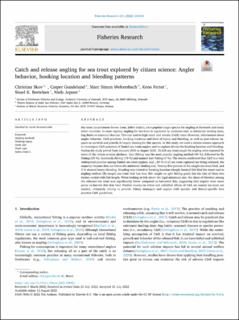| dc.description.abstract | Sea trout (anadromous brown trout, Salmo trutta L.) is a popular target species for angling in Denmark and many other countries. In most regions, angling for sea trout is regulated by measures such as minimum landing sizes, bag limits or seasonal closures. This can lead to high catch and release (C&R) rates. However, information about angler behavior, C&R practices, hooking locations and level of injury and bleeding, as well as post-release impacts on survival and growth, is largely missing for this species. In this study, we used a citizen science approach to investigate C&R practices of Danish sea trout anglers and to explore drivers for hooking location and bleeding. During the study period from January 2016 to August 2021, 35,826 sea trout caught by angling were reported by users of the citizen science platform. Spin fishing was the most popular angling method (46 %), followed by fly fishing (35 %), bombarda fishing (19 %) and natural bait fishing (1 %). The results confirmed that C&R is a very widespread practice among Danish sea trout anglers, and ≥80 % of all sea trout captured are being released, the majority because they are below the minimum landing size. Twenty-five percent of the caught sea trout bled, and 2 % showed heavy bleeding. Bleeding was related to hooking location (deeply hooked fish bled the most) and to angling method (fly-caught sea trout bled less than fish caught on spin fishing gear), but the role of these two factors varied with fish length. When looking at fish above the legal minimum size, the share of bleeders among the released sea trout was significantly lower compared to harvested fish, suggesting that anglers were more prone to harvest fish that bled. Further studies on lethal and sublethal effects of C&R on coastal sea trout are needed, ultimately aiming to provide fishery managers and anglers with species- and fishery-specific best practice C&R guidelines. | en_US |
